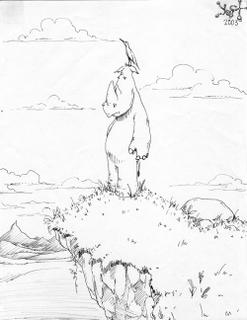A City Shrouded in Mystery
.
Well, my fate is sealed! I am flunking my first honours paper. The Digital Design section was somewhat of an enigma to me. I could only speculate as to what the questions meant (were they questions at all?). The whole experience was as mysterious as the ancient Incan city of Machu Picchu in Peru. It was a technological wonder far beyond the capabilities of the age. Here are some interesting facts about the ancient city:
Machu Picchu is one of the few places left unscathed by the conquering Spaniards. Searching for more gold, Pizarro marched his men up the Urubamba River and around the horseshoe bend at the base of the mountain! Serenely perched 1500 feet above the thundering waters, Machu Picchu escaped the fate of most of the Inca empire. At some point, for reasons that elude us, life in the city ended and the forest took dominion. It was rediscovered in 1911 by a young American named Hiram Bingham. It is now generally thought that at the time of the conquest, knowledge of Machu Picchu had been lost by the Incas themselves. This hasn't stopped modern historians from somehow attributing its construction to Pachacutec, the 9th Inca who reigned in the mid 15th century, and gets credit for much of the achievements of that civilization.
It is now generally thought that at the time of the conquest, knowledge of Machu Picchu had been lost by the Incas themselves. This hasn't stopped modern historians from somehow attributing its construction to Pachacutec, the 9th Inca who reigned in the mid 15th century, and gets credit for much of the achievements of that civilization.
Hiram Bingham was told of a plant whose juices softened rock so that the surfaces would join perfectly. There are reports of such a plant, including this one by one of the early Spanish Chroniclers: “While encamped by a rocky river, he watched a bird with a leaf in its beak light on a rock, lay down the leaf and peck at it. The next day the bird returned. By then there was a concavity where the leaf had been. By this method the bird created a drinking cup to catch the splashing waters of the river.” Considering the fact that lichen softens stone to attach its roots, and considering the ongoing extinction of plant species, perhaps this isn't really such a far-fetched notion. Eric Von Daniken, in his series of books beginning with Chariots of the Gods theorized that the Andean stoneworks were built by Alien/Gods who visited the earth long ago, bringing civilization to primitive man. The scientific community simply snickered. Whatever one thinks of his theories, he brought to the public an awareness of the many ancient monuments on earth that seem to defy rational explanation.
Eric Von Daniken, in his series of books beginning with Chariots of the Gods theorized that the Andean stoneworks were built by Alien/Gods who visited the earth long ago, bringing civilization to primitive man. The scientific community simply snickered. Whatever one thinks of his theories, he brought to the public an awareness of the many ancient monuments on earth that seem to defy rational explanation.
In his novel "Slapstick" Kurt Vonnegut quips:
"...there must have been days of light gravity in old times, when people could play tiddley winks with huge chunks of stone."
Pedro de Cieza de Leon wrote of an old Inca legend about the creator-god, Viracocha. Once to show his power he caused a huge fire, then extinguished it. As a result of having been burnt so, the stones were so light that even a large one could be picked up as though it were made of cork..
But the real truth behind this ancient architecture will always remain hidden in the murky depths of time. We can but speculate…

Absolutist’s Guide to the Universe Toothpick: A toothpick is among the most important things you need when on an adventure cruise to the marshy delta region of Caviterisius III. The entire planet is a delta region but the actual river has never been found. It’s a major tourist destination famous for its luxurious summer cruises. The major attractions are the three headed water snakes, the mammoth flying fishes, the subterranean homesick aliens, the great pillars of Guanetiro made entirely of flying fish droppings and ofcourse the lovely evening sky with 2 and a half moons. But unfortunately the
Toothpick: A toothpick is among the most important things you need when on an adventure cruise to the marshy delta region of Caviterisius III. The entire planet is a delta region but the actual river has never been found. It’s a major tourist destination famous for its luxurious summer cruises. The major attractions are the three headed water snakes, the mammoth flying fishes, the subterranean homesick aliens, the great pillars of Guanetiro made entirely of flying fish droppings and ofcourse the lovely evening sky with 2 and a half moons. But unfortunately the dominant species on the planet are microscopic lifeforms commonly known to be the cause of severe tooth decay. So while on the planet tourists are advised to keep their teeth sparkling clean with the use of toothpicks. The resident organisms are known to digest entire dentures in a matter of seconds. Overall it is an adventure of a lifetime for those with detachable dentures.
dominant species on the planet are microscopic lifeforms commonly known to be the cause of severe tooth decay. So while on the planet tourists are advised to keep their teeth sparkling clean with the use of toothpicks. The resident organisms are known to digest entire dentures in a matter of seconds. Overall it is an adventure of a lifetime for those with detachable dentures.
























